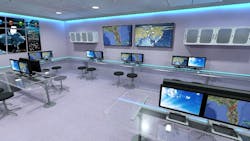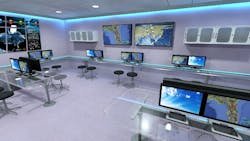Virtual flight lab conveys need for STEM education, future pilot workforce, flight training innovation
By Sierra Jones, Office of Naval Research
ARLINGTON, Va. If you've ever dreamed of donning a flight helmet and getting into the cockpit of a fighter jet, now is your opportunity. The Orlando Science Center, in partnership with the Office of Naval Research (ONR), has opened its new Flight Lab, a permanent exhibit that provides visitors with a virtual, hands-on experience learning how to pilot an F-35B -- the Marine Corps variant of Lockheed Martin’s Lightning II Joint Strike Fighter, the most advanced aircraft on Earth.
For actual Navy and Marine Corps pilots, learning to fly takes dedication and years of specialized training. However, visitors to this interactive exhibit can skip all that and experience real-world missions-while having fun and learning about the science, technology, engineering, and math (STEM) concepts used during flight.
"Visitors to the exhibit will leave knowing what it feels like to be a fighter pilot," says Dr. Peter Squire, a program officer in ONR's Expeditionary Maneuver Warfare Department. "But the experience will also provide an understanding that there is more to it than just flying around. Whether in an F-35B or a commercial airliner, there are similar math, engineering, and other scientific principles used when in the sky."
As the Navy and Marine Corps look to develop the next-generation workforce -- be it aviators, scientists, or engineers -- it will be important for them to have a strong understanding of STEM concepts.
"Having a workforce with STEM skills is critical for ensuring that the Navy and Marine Corps can continue to meet the challenges of today and tomorrow," Squire says. "What this exhibit does is provide broad exposure to the types of scientific principles our future workforce needs, while increasing student interest and understanding of science applications to military challenges."
The Flight Lab, using 13 Oculus Rift virtual display units, will invite visitors to test their aviation skills as either a pilot or co-pilot and work together to complete a mission. During these missions, co-pilots will have to solve math problems-such as determining the amount of fuel, the speed and weight among other factors, before telling the pilot where to go and how fast to get there. And though the missions vary-some requiring all 13 teams to work together, with others pitting the best pilots against one another-the goal is the always the same: Help Sailors and Marines maintain the advantage and return home safely.
“One of our main objectives is to create a fun and engaging way to teach about the mathematics involved in aviation and engineering,” says Brandan Lanman, vice president of visitor experience at Orlando Science Center. “So as the co-pilot, you have the task of solving the math problems that are associated with getting your aircraft where it needs to be. … It’s using real-world applications to show the practical use of mathematics in our everyday life, and how amazing is it that you get to fly an F-35B to do it?”
In addition to offering a new, engaging experience, Flight Lab will support STEM education by helping the next generation develop skills they will need to be scientists, engineers, aviators, technicians, and other STEM professionals.
This Flight Lab was funded by a grant from ONR. Additional support has been provided by the Naval Air Warfare Center Training Systems Division, TEQGames, and Lockheed Martin, whose flight training software has been used to teach real pilots to fly.
The exhibit will be used not only as a daily experience for visitors to the science center, but also as part of summer camps and workshops. It joins the Orlando Science Center's other experiences including an observatory, traveling exhibits, educational films, live shows and various other exhibits and discovery labs.
Sierra Jones is a contractor for ONR Corporate Strategic Communications.
The Department of the Navy's Office of Naval Research provides the science and technology necessary to maintain the Navy and Marine Corps' technological advantage. Through its affiliates, ONR is a leader in science and technology with engagement in 50 states, 55 countries, 634 institutions of higher learning and nonprofit institutions, and more than 960 industry partners. ONR, through its commands, including headquarters, ONR Global and the Naval Research Laboratory in Washington, D.C., employs more than 3,800 people, comprising uniformed, civilian and contract personnel.
The go-to resource for Intelligent Aerospace technology news & information:
Covering key topics
Across all market segments
Subscribe to the free Intelligent Inbox e-newsletter: http://www.intelligent-aerospace.com/subscribe.html.
Connect on social media:
Keep pace with aerospace innovation and opportunities via your favorite social media channels. Connect with Intelligent Aerospace on Twitter (@IntelligentAero), LinkedIn,Google+, and Instagram.
Intelligent Aerospace, the global aerospace technology network, reports on the latest tools, technologies, and trends of vital importance to aerospace professionals throughout the industry and around the globe, including engineers, engineering managers, and other key decision-makers involved in the research & development, design, test, manufacture, maintenance, upgrade and retrofit, management, and acquisition of electronics hardware and software components, tools, and systems for commercial and military fixed-wing, rotor-wing, and unmanned aircraft, air traffic control, airport operations, satellites, and space.


